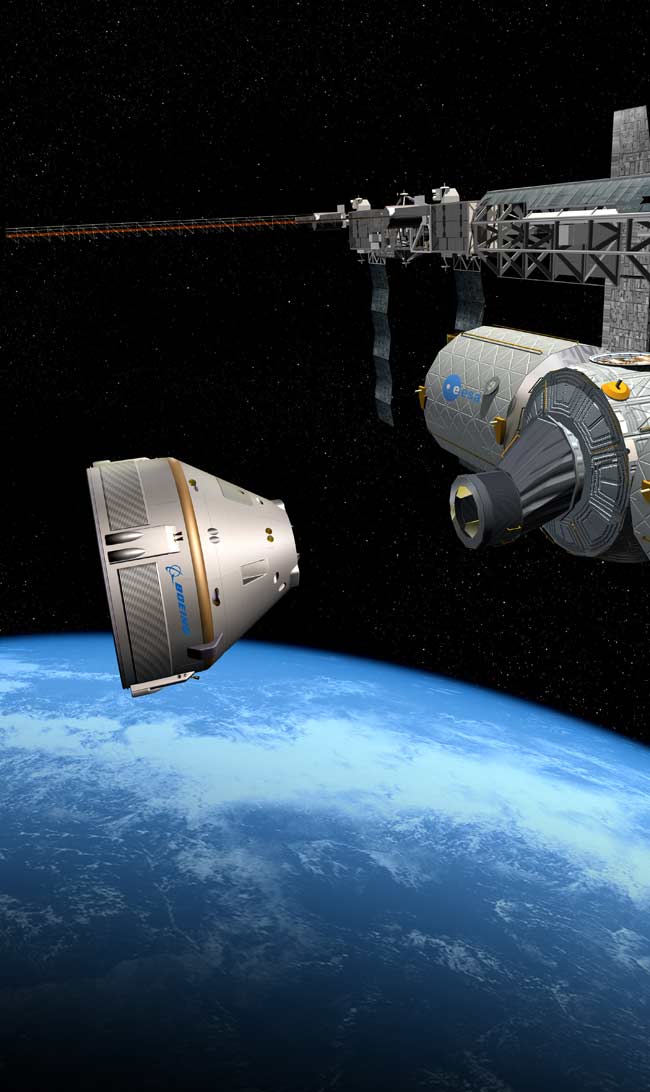Boeing Moves Forward With Commercial Space Capsule

Withthe impending retirement of NASA's space shuttle fleet, aerospace juggernautBoeing is hard at work developing a new capsule-based spaceship that could beready for its first commercial spaceflight by 2015.
Boeing'snew CrewSpace Transportation-100 spacecraftis designed to fly astronauts to and from the International Space Station(ISS), as well as futureprivate space stations.
KeithReiley, Boeing's commercial crew development program manager, will bepresenting updates on the Commercial Crew Transportation System at the AmericanInstitute of Aeronautics and Astronautic Space 2010 Conference and Expositionnext week in Anaheim, Calif.
Buildingon experience
Asone of the leading suppliers of human space systems and services, Boeingalready has a strong heritage in the industry. [Video:Boeing's New Spacecraft]
"Itwas an enormous advantage," Reiley told SPACE.com. "A lot of theequipment we're looking at has ISS heritage. About half of our team weredesigners that came from ISS and had experience with the flight hardware. Theother half were space shuttle designers."
Tohelp reach its goal, the company looked to existing facilities, launchers andproven processes to ensure safety, lower development costs and reduce overallrisk.
Get the Space.com Newsletter
Breaking space news, the latest updates on rocket launches, skywatching events and more!
Boeing'sCST-100 spacecraft is approximately 15 feet (4.5 meters) wide and can carry upto seven people. The cone-shaped capsule will look similar to NASA's Apollo andOrion spacecraft.
Boeingsettled on the cone-shaped design because it was thought to be the safest andmost inexpensive of the vehicle concepts that were considered, ?Reiley said.
Pushylaunch escape system
Thespacecraft is being designed for compatibility with a variety of rockets,including United Launch Alliance's Atlas and Delta boosters and SpaceX'sFalcon rockets. This will give Boeingthe flexibility to select an appropriate rocket later in the developmentprocess.
Thespacecraft will also be equipped with a unique pusher abort system in case thecrew encounters an emergency during launch.
"Thisis the first time anyone has proposed or succeeded with a pusher design,"Reiley said. "The pusher appears, to us, to be simpler, less expensive andjust as safe."
Ifnecessary, the launch abort system would fire pressurized propellant for threeseconds to quickly push the vehicle away from the rocket. A parachute wouldthen be deployed to assist with the landing.
Oneof the advantages of the pusher design is that in the event of a smooth launch,the same propellant can also be used on orbit, either in guiding the CST-100 todock with a space station, or to boost stations themselves, whose orbits slowlydecay over time.
"Youget the ability to use the propellant to re-boost our customerstations or simply for orbitalmaneuvering to get there," Reiley said. "In order to catch up withthe station you're trying to rendezvous with, you have to boost yourself up tothe station's orbit, and all that takes a certain amount of fuel."
ForBoeing, one of their main challenges in expanding their branch of commercialspaceflight is in designing a relatively inexpensive option.
Thecompany has set a design requirement that the CST-100 be reusable up to 10times. The exact number of times the capsule is reused, however, will dependupon inspection after touchdown.
TheCST-100 is part of the company's $18 million award from NASA under theCommercial Crew Development (CCDev) Space Act Agreement. The award aims toadvance the concepts and technology required to build a commercial crew spacetransportation system.
Boeing'scapsule design is one of several efforts by different U.S. companies to developthe first private spaceship capable of flying humans to space. The push fits inwith President Barack Obama's new plan for NASA, which calls for commercialspacecraft to take over the role vacated by the space shuttles of transportingastronauts to the space station.
- Top10 Fantasy Spaceships Turning Into Reality
- NASA'sMost Memorable Space Missions
- 6Private Companies That Could Launch Humans Into Space
Join our Space Forums to keep talking space on the latest missions, night sky and more! And if you have a news tip, correction or comment, let us know at: community@space.com.

Denise Chow is a former Space.com staff writer who then worked as assistant managing editor at Live Science before moving to NBC News as a science reporter, where she focuses on general science and climate change. She spent two years with Space.com, writing about rocket launches and covering NASA's final three space shuttle missions, before joining the Live Science team in 2013. A Canadian transplant, Denise has a bachelor's degree from the University of Toronto, and a master's degree in journalism from New York University. At NBC News, Denise covers general science and climate change.









